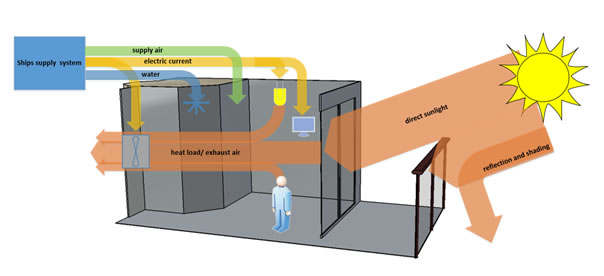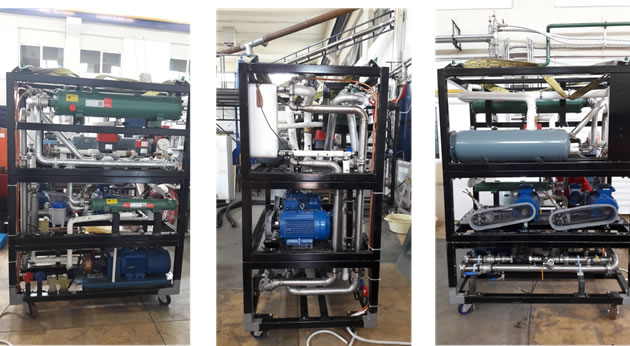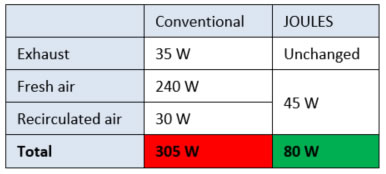Demonstrator selection
Approach
The baseline for the demonstrator selection process is a criteria catalogue that was agreed by the consortium and documented in the public Deliverable D 61.1 Demonstrator selection criteria. According to the criteria catalogue, the following elements have to be observed:
- base data of a proposed demonstrator (allocation to application area(s), suggested schedule and budget, outlined exploitation roadmap)
- criteria for a qualitative assessment (Attractiveness for the JOULES project, Attractiveness for the partners involved, Attractiveness for the Commission / for the public, Progress beyond state of the art, Uniqueness, Nature of results) - each having a weighting factor and broken down into sub criteria
- criteria for a quantitative assessment (Environmental merits, Economical merits, Impact Europe, Impact World, Reduced fuel consumption in target market) - also provided with sub criteria and weighting factors.
Three demonstrator proposals, each being related to a different area of application, passed the evaluation which was finalized in month 37 of the project. Subsequently, the consortium took the decision to build, operate and validate the following physical demonstrators in the time prior to the Milestone in month 45:
L.E. Cab (Low Energy Cabin) – proposed by Meyer Werft GmbH
In conventional cruise vessels, passenger comfort is the main objective of the cabin specification. Consequently, the specification for a passenger cabin concentrates on increasing the cabins attractiveness and passenger comfort. Energy efficiency and sustainability have minor priority. All consumption like water, air, electrical energy or chilling systems are supplied by the ships energy system, which gains energy by converting fossil fuel into electrical energy. The amount of required electrical energy is determined by the components of cabin's energy system and its use profile.
 State of the art cabin design
State of the art cabin design
Partly decentralized Air Conditioning System
The principle idea of the air conditioning system in the L.E. Cab demonstrator is to do all air conditioning in the cabin rather than transport air from a centralised air conditioning system to the cabin. This reduces the electrical energy effort by reducing the pressure loss.
For the approach, it is necessary to have a complete air conditioning system in the cabin rather than a fan coil as it is state of the art. This means an enormous technical effort.
On long term, the idea is to have a fully decentralised air conditioning system. This would include a decentralised exhaust air system, too. The decentralised blow off of exhaust air is technically possible. But there are several administrative obstacles. It has to be ensured, that air short circuits are avoided. As a first step the fresh air supply is decentralised. This means a significant step towards a fully decentralised air conditioning system. In this first step, the technical feasibility was proven. The technological step is enormous while the administrative effort is moderate.
Electrical DC grid
Nowadays, cabins are equipped with an electrical alternating current (AC) system and the ship's electric grid is considered to be the only energy source. The new approach in the electrical system of the cabin is that the electrical grid of the cabin will be based on direct current (DC) technology. The reason for this new approach is the high potential expected from reduced conversion losses, especially in the context of the use of locally produced energy.
 L.E. Cab Design
L.E. Cab Design
In principle, a DC- grid is already validated in automotive industry. In case of decentralised energy supply for cabins, the cabin networks are not completely independent. In some situations, the isolated networks interact, which is a new technology.
The electrical system is specified to work with the energy supply of the local energy harvesting system, as well as with the ship's power system as a backup to ensure the energy supply at all times.
Lightweight
The equipment of the cabin with new technologies such as solar cells and an energy storage and management system leads unavoidable to the fact that the overall cabin weight is increasing. Taking into account the main goal of the L.E. Cab design to significantly reduce the overall energy consumption an increase in the weight of the cabin is not permissible.
In order to compensate this additional weight a lightweight design approach with new lightweight materials for the cabin hull were investigated.
Marine ORC Demonstrator – proposed by DNV GL
Waste Heat Recovery (WHR) systems aim at reclaiming wasted thermal energy and converting it to mechanical power following the thermodynamic transitions of the Rankine cycle. The working fluid can be either water/steam, or an organic medium (R134a, R245fa, etc.). Unlike steam, the organic Rankine cycle (ORC) can successfully reclaim waste heat from low temperature heat sources at the order of 90°C, such as the exhaust gas stream of small auxiliary engines, or the jacket water coolant or lubricating oil networks found on-board ships.
 Marine ORC unit, the three separate module s can be easily distinguished
Marine ORC unit, the three separate module s can be easily distinguished
Despite the technology readiness of ORC systems, marine references are still limited. The JOULES Marine ORC demonstrator measures and quantify the actual of a prototype marinized ORC unit and employ advanced simulation and lifecycle assessment tools to analyse the technology operation and estimate life-cycle impact. The ORC unit was designed for on-board waste heat recovery from the cooling water network of a ship's main engine. Due to the experimental nature of the ORC unit, the system was equipped with measuring devices that provide the advantage of extensive performance monitoring.
The Demonstrator performed extensive testing of the operation of the marinized unit and analysed its performance and operability at various conditions. The data acquired during the unit testing were used to calibrate and verify advanced simulation models, which were further used to demonstrate the unit's power production capability and energy efficiency for a realistic operational profile of a vessel.
ODOT (Operational Displacement Optimisation Tool) – proposed by STX France SA
The consumption of marine fuel can be reduced in a number of ways, of which the most obvious ones are the reduction of a ship's speed, improvement of the marine engine's efficiency and reduction of the ship's mass. The less evident measures include optimization of a ship's trim. This latter method is poorly explored and rarely used. However, it has a great potential as, unlike other measures, it can be used without loss of competitiveness, with the help of the existing technology and on the existing ships.
An optimized trim is obtained by manipulating the magnitude and tridimensional distribution of a ship's mass. Studies have shown that for the same displacement, a variation in trim can reduce fuel consumption by as much as 7 %. But while it is impractical to change the mass of the existing ships' structures or, out of consideration for profitability, to reduce the mass of the cargo, it is possible to change the mass and distribution of the ship's capacities.
Although the idea of reducing fuel consumption by reducing a ship's trim is quite simple, its practical realization is not necessarily easy. The ship operator, in deciding which capacities must be emptied or filled, has to consider several factors such as the masses and tridimensional coordinates of the capacities, the free surface effects of the partially filled tanks, relative importance of the capacities and their availability in the next port of call, the costs of the capacities proper and any additional costs associated with emptying or filling of the tanks, speed with which the tanks can be filled or emptied and ship's time constraints, availability of deckhands, weather forecast and, last but not least important, the effects of the changes in the capacities' masses on the ship's stability and longitudinal strength. Above all, a decision must be made quickly so that the operator can proceed with other routine operations while in port.
It is obvious that in order to make a decision of such complexity and urgency, the ship operator must rely on software which will take into account most of the above-mentioned factors and instantly propose a loading scenario which reconciles several operational, economic and maritime criteria while permitting the reduction of fuel consumption. Developing such a software is the purpose of this project.
L.E. Cab – Low Energy Cabin

Partly decentralized Air Conditioning System
At an air volume flow of 75m³/h, the blowers in the fan coils consumes 45 W electrical power in total. A measurement campaign was undertaken which included measurements in the state of the art air conditioning. The ship used was a river cruiser built in 2015 at Neptun Werft in Rostock, Germany.
The air flow scheme in the new air conditioning system differs from the conventional system. The electrical consumption of the blowers was measured together.
Electrical DC grid
By using LED technology the electrical consumption for lighting was reduced significantly.

Several measurements were run with the organic photovoltaic system. The solar radiation model was used to simulate the same situation (date, time of day, clear sky, global position). The solar radiation was used to calculate the expected earnings by an organic photo voltaic panel.
The simulations results for horizontal orientation and orthogonal orientation match with the measured results, if an efficiency of 3,5% is estimated. As an efficiency of 5,5% is feasible in near future, a cabin will be able to supply itself if the whole balustrade is used as harvesting area
Lightweight
Through the use of a new lightweight material for the cabin hull, the overall weight of the cabin could be reduced. Both the weight of the cabin walls and the weight of the cabin ceiling could be reduced by 30-35 %.
Furthermore, the weight calculations have shown that the complete cabin including floor is lighter than the reference cabin with the conventional material without floor.
With this lightweight approach in the L.E. Cab design it has been possible to more than compensate for the additional weight of the OPV-system, the energy storage system including energy management and air conditioning device.
More information about the L.E. Cab demonstrator, including results of the assessment of technical properties and Life Cycle Costs can be found in the public Deliverable D62.2 which will be made available on the JOULES website.
Marine ORC Demonstrator
The real impact of the Demonstrator and its potential scale-ups were assessed based on the simulation model results and the JOULES LCPA tool. Using the results of the COSSMOS model-based simulations as input to the LCPA analysis, the environmental and financial benefits from the potential use of the ORC technology was estimated for both waste heat recovery options: (i) the high temperature cooling network and the exhaust gas stream. The analysis is conducted for variant price scenarios. The improvement in the Key Performance Indicators against the baseline scenario (without ORC unit) were estimated as follows:
| Waste heat recovery from: High temperature main engine cooling network | Waste heat recovery from: Exhaust gas stream | |
| Global Warming Potential (GWP, in kg of CO2 equivalent) | 0.8% | 2.3% |
| Cumulative Energy Demand (CED, in J) | 0.8% | 2.4% |
| Cumulative cost savings in Net Present Value (NPV, in EUR) - Mid price scenario | 0.6% | 2.0% |
| Eutrophication potential (EP, in kg of PO4 equivalent) | 0.5% | 1.4% |
| Acidification Potential (AP, in kg of SO2 equivalent) | 0.5% | 1.4% |
| Particulate Matter emissions (PM10, in kg PM10) | 0.7% | 2.2% |
In summary, the partners in this work could exploit the results of the Demonstrator as follows:
From the yard perspective, motivation stems from the need to provide real-life examples of new technology implementation for the shipping market, in order to prove technical feasibility and drive the market towards adopting novel energy efficiency concepts. In this regard, FSG will exploit the Marine ORC demonstrator for integrating novel waste heat recovery technologies like ORC on-boardnew projected ships, proving that there is strong technical expertise and know-how for moving the technology forefront beyond the spectrum of conventional solutions.
From the class perspective, DNV GL is strongly motivated to holistically explore the impact of novel ship technologies in terms of safety, environmental performance and effectiveness. Driven by the purpose of safeguarding life, property and the environment, DNV GL aims to enable the shipping industry to advance the safety and sustainability of everyday maritime operations. In this regard, it is very important to estimate the environmental, energy efficiency and safety aspects of new technologies, either on case-specific or fleet-level basis. Having approximately the 25% of the global fleet in its class, DNV GL is the leading class society and thus its role is crucial in achieving the environmental and energy efficiency objectives of the global maritime industry. DNV GL will exploit the capabilities and expertise developed in the Marine ORC demonstrator, to assist shipping companies in the decision making process for energy efficiency and sustainability solutions.
Moreover, it is expected that the results of the Marine ORC Demonstrator may be disseminated to the industry aiming at the general knowledge increase and sharing.
Further information, including experiments with the marinized ORC unit, set-up and verification of an ORC simulation model, model-based scale-up studies for energy recovery from cooling systems and exhaust gases, and LCPA studies, can be obtained from the public Deliverable D62.4 which will be made available on the JOULES website.
ODOT – Operational Displacement Optimisation Tool
Virtual Test
The program has been tested on a virtual ship. This step has served to verify our assumptions about the ship's geometry, stability, strength, loading patterns and hydrodynamic performance. It has also permitted the preliminary quantification of energy gains resulting from the trim optimization.
The virtual ship has been modelled after the Armorique, a fast ferry operated by the Brittany Ferries and transporting cars and passengers between the South Coast of the UK and the North of French. Her capacities constitute more than 60% of the total mass aboard the ship. The algorithm was applied to 11 of the 58 tanks.
The improved hydrodynamic performance resulting from a new loading scenario was estimated to an average of 3.8 x 10-3 t of fuel per nautical mile (about 500 t of fuel per year)
Real Test onboard
On March 29, 2017, the algorithm was tested aboard the Armorique during one of the ship's regular passages from Roscoff to Plymouth. A typical Roscoff-Plymouth voyage is conducted at the cruising speed of 22-23 knots and takes 5.5 hours. The evolution of the ship's speed as it left the reduced speed zone and entered the open water was monitored. The average speed for this part of the voyage was 22.6 knots.
Approximately 1.5h h after the beginning of the voyage, the ODOT algorithm was deployed so as to optimize the ship's loading. A number of optimized loading scenarios were calculated out of which one scenario was selected by the Segula's test engineer and the ship's captain, taking into consideration the algorithm's recommendations as well as the solution's practicality, ship's safety and imperative not to reduce the speed.
Specifically, the selected solution involved emptying three aft ballast tanks (BW1P, BW1S and SKEG) of the total volume of 184 m3, a measure which resulted in a 0.35 m trim reduction. The ballast operation took approximately 0.5 h during which time the ship continued without reducing its speed.
Further information, including the optimisation method applied and how the test campaign was performed, can be obtained from the public Deliverable D62.6 which will be made available on the JOULES website.


